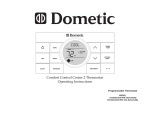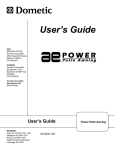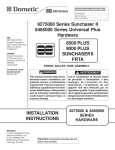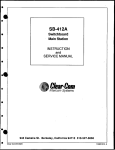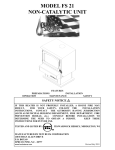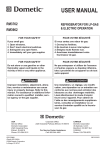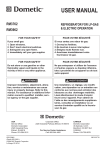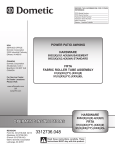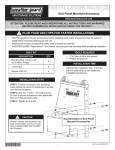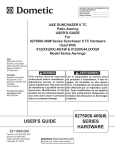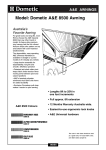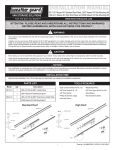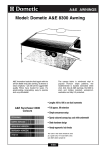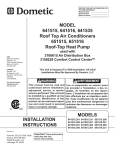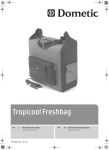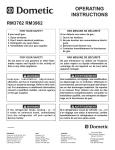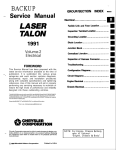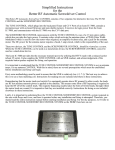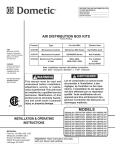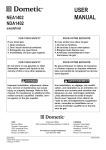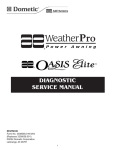Download 9/6/07 Patio Awning Diagnostic Service Manual A & E
Transcript
DIAGNOSTIC SERVICE MANUAL A&E SUNCHASER, 8500, 9000 Patio Awnings USA SERVICE OFFICE Dometic Corporation 2320 Industrial Parkway Elkhart, IN 46516 574-294-2511 CANADA Dometic Distribution 46 Zatonski Unit 3 Brantford, Ontario CANADA N3T 5L8 519-720-9578 REVISION Form No. 3106934.015 9/07 (Replaces 3106934.007) ©2007 Dometic Corporation LaGrange, IN 46761 Safety Instructions This manual has safety information and instructions to help users eliminate or reduce the risk of accidents and injuries. Recognize Safety Information This service manual is the result of the dedication of The Dometic Corporation Technical, Warranty and its engineering staff in giving service people the necessary instruction for making accurate analyses of certain conditions. Provided is a diagnostic chart leading a qualified mechanic into the service manual pages to locate and solve symptoms which may occur. Dometic has continued its commitment in providing service people with this, the most up-to-date information about servicing Dometic RV accessories. This is the safety-alert symbol. When you see this symbol in this manual, be alert to the potential for personal injury. Follow recommended precautions and safe operating instructions. Understand Signal Words A signal word , WARNING OR CAUTION is used with the safety-alert symbol. They give the level of risk for potential injury. Indicates a potentially hazardous situation which, if not avoided, could result in death or serious injury. Indicates a potentially hazardous situation which, if not avoided may result in minor or moderate injury. When used without the safety alert symbol indicates, a potentially hazardous situation which, if not avoided may result in property damage. Read and follow all safety information and instructions. CONTENTS PAGE NO. Diagnostic Flow Chart...................................................................4 Section 1 Operation 1.1 1.2 Open............................................................................................................ 5 Close........................................................................................................... 6 Section 2 Hardware Components 2.1 2.2 2.3 2.4 2.5 2.6 2.7 2.8 Special Nut.................................................................................................. 8 Black Adjustment Knob............................................................................. 8 Lift Handle Lock Button............................................................................. 8 Adjustable Arm Assembly......................................................................... 8 Top Mounting Bracket............................................................................... 9 Bottom Mounting Bracket......................................................................... 9 Stop Plug.................................................................................................. 10 Rafters....................................................................................................... 10 Section 3 Fabric Roller Tube Assembly (FRTA) 3.1 Fabric........................................................................................................ 10 3.2 3.3 3.4 3.1.1 Position............................................................................................ 10 3.1.2 Tek Screws....................................................................................... 10 3.1.3 Square.............................................................................................. 11 3.1.4 Seams............................................................................................... 11 3.1.5 Stitches............................................................................................ 11 3.1.6 Fabric / Roller / Torsion Change.................................................... 11 Pull Strap.................................................................................................. 17 Roller Tube................................................................................................ 17 Torsions.................................................................................................... 17 3.4.1 Cam Lock......................................................................................... 17 Awning Rail............................................................................................... 17 Sidewall..................................................................................................... 17 Section 4 Other 4.1 4.2 This program will address the most common system problems associated with the A&E Patio Awnings supplied by Dometic Corporation. Our intent is to provide you with a guideline of checks to make, should you encounter one of the following symptoms. Symptom Cause Refer To Page 1. Black adjustment knob will not tighten Special Nut Knob 2.1 2.2 8 8 2. Main support arm will not extend Lift Handle Lock Button Adjustable Arm 2.3 2.4 8 8 3. Awning will not roll up straight Fabric Position Fabric Square 3.1.1 3.1.3 10 11 4. Weatherguard wrinkled Seams Sidewall 3.1.4 4.2 11 17 5. Fabric does not hang well Tek Screws Tube Deflection Sidewall Out of square Stitches Seams 3.1.2 3.3 4.2 3.1.3 3.1.5 3.1.4 10 17 17 11 11 11 6. Must lift arm (s) to open awning Stop Plug Bottom Mounting Brackets 2.7 2.6 10 9 7. Awning arm (s) stay up against side of coach when trying to open awning Top Mounting Brackets Fabric Position Operation 2.5 3.1.1 1.2 9 10 7 8. Awning will not roll up Rafters Black Adjustment Knob Torsions 2.8 2.2 3.4 10 8 17 9. Awning will not stay in rolled down position Cam Lock 3.4.1 17 10. Fabric leaks at roller tube Stitches 3.1.5 11 11. Awning stops at guard when rolling up Rafters Stop Plug Torsions Awning Rail Top Mounting Bracket Operation 2.8 2.7 3.4 4.1 2.5 1.2 10 10 17 17 9 7 Operation 1.1 To Open 3. Extend FRTA 1. Loosen Knob and Unlock Hardware Loosen Knob 3 Hook the rod in loop, and pull all the way out. Sunchaser: Squeeze 4. Extend and Secure Rafters 8500/9000: Flip 2. Unlock Fabric Roller Tube Assembily (FRTA) Slide one rafter arm up until it snaps into place. Pull down and out on the sliding rafter to remove slack from the fabric. Tighten the black adjustment knob. The tighter the rafters are the better the fabric look and be less prown to wind whipping. Repeat for other side. Pull down. Ensure the lock lever is not flipped to the “rollup” position prior to swinging the main arm away from coach. Failure to do so can cause damage to the lock mechanism. Slide the pull strap to the right end of the tube and wrap as shown. 1.2 TO CLOSE 5. Height Adjustment 1. From Patio Position Pull stakes from the ground, lower arm to the shortest position, swing arm toward the vehicle, and snap the patio foot into the bracket. Repeat for other side and proceed to next step. Pull up on the lift handle and raise to desired height. Swing handle down to lock button in hole. Repeat for other side. 6. Carport Position Ensure that the lock is in the “roll-down” position prior to swinging arms toward vehicle. Failure to do so can cause damage to the lock mechanism. 2. Lower Arms To Stop Bolts Lower arm to shortest position. Press the release lever and pull the arm away to a vertical position. Adjust height. Drive stakes through holes in patio foot into the ground. Repeat for other side. Whenever heavy or prolonged rain or wind is anticipated, or you will leave the awning unattended, it is best to close the awning. Damage as a result of weather is not covered by warranty. Raise the lift handle to release the lock button. Lower main arm to the stop plug. Swing the handle down to engage the lock button in a hole. Repeat for other side. 3. Loosen knob and release slider 7.Rain Position During light rain, lower end opposite from door to shed water and prevent pooling. Slide the rafter arm down to the bottom of the main arm. Leave black adjustment knob loose. Repeat for other side. 4. Roll Up FRTA. HELPFUL HINTS FOR AWNING CARE • Grasp the pull strap, pull toward you, and flip the locking lever up to the ROLL UP position. Do not release the awning pull strap now. It is under tension and could snap back against the vehicle side. Slide the pull strap to the center, and using it to control speed, allow the awning to return to the vehicle side. Note: Allow the strap to wind diagonally to prevent a bulge in the fabric. On the 9000 series, when rolling up the awning, the roller tube assembly should not be slowed down before reaching the aluminum guard. This could cause the roller tube to stall at the guard. Tighten black adjustment knob. Sunchaser Awnings: Squeeze rafter into arms to engage latch. 8500 & 9000: Flip travel lock latch down. Repeat for other side. Your awning is now ready for travel. Whenever the awning is wet while rolled up, as soon as conditions allow, roll it out and let it dry before rolling it up again. This will help prevent mildew. • Mildew does not form on the fabric itself, but on the accumulated dust and dirt. Periodically clean vinyl or woven acrylic. • Always make sure the awning is extended high enough before opening the entry door. • Apply silicone spray lubricant as needed to keep the awning’s moving parts operating smoothly. For ease of operation on hardware, rub candle wax on all sliding surfaces. 8500 and 8300 • Abrasion and weather are vinyl’s worst enemies. To avoid these problems, you will need to keep your awning clean. Use a mixture of 1/4 cup dish soap, 1/4 cup liquid bleach and five gallons of warm fresh water. Soap the top side of the fabric with this mixture, then roll it up and let stand for five minutes. Rolling up the awning will apply the mixture to the underside of the fabric. Unroll the awning and hose off the top and bottom with clean water. Repeat if necessary and allow to completely dry. A&E 9000 • In addition to its beauty and soft translucence, woven acrylic fabric offers the advantages of strength and breath ability. It is water repellent, but because it is a woven cloth, it is not water proof. To keep your acrylic awning clean, simply hose it off occasionally and let it dry. Do Not Scrub. • Avoid touching the underside of the 9000 canopy when it is wet. To do so will break the surface tension of the water and encourage seepage through the fabric. • Because acrylic is a woven fabric, shifting may occur if the awning and pull strap are not centrally aligned with the fabric roller tube while the awning is being rolled up. If necessary, roll the awning out and adjust the alignment. SECTION 2 to be cut off for removal. Using a hack saw cut the knob stud as close to the rafter as possible without hurting the finish on the rafter. Replace with new nut, Part number 3307663.017. Dometic has used several versions of the nut for the knob. The current nut will fit hardware back to the first generation used in 1992. Prior to the special nut the hardware used a nutsert to hold the knob tight (930022). Apply spray lubricant to the threaded portion of the nut and knob once a year or as needed for smooth operation. Hardware Components Top Mounting Bracket Main Rafter Knob With Nut Knob With Nut Secondary Rafter Slider 2.2 Black Adjustment Knob The black adjustment knob tightens the secondary rafter to the main rafter to keep the fabric taut in the full open position. When closing the awning, the knob should not be tightened down until after the awning is rolled up and the travel lock is engaged. Attempting to open the awning without first loosening the black adjustment knobs can damage the slider of the secondary rafter, making it difficult to open the awning. Apply spray lubricant to the threaded portion of the knob once a year or as needed for smooth operation. If knob is frozen to nut it will need to be replaced with part number 3105421.014. Main Support Arm Slider Catch Travel Lock Lift-Lock Handle 2.3 Lift Handle Lock Button The push button of the lift-lock assembly locks the main support arm to the adjustable arm assembly and controls the height of the awning in the open position. To check it, open the awning to full extension. Look inside the mainsupport arm, and activate the button to see if the locking pin is moving in and out of the hole in the adjustable arm assembly. If the locking pin does not move, or has been broken off, the lift handle assembly must be replaced. At times the lock pin of the lift handle assembly can break off and jam between the lift handle assembly and the adjustable arm assembly, making it difficult to extend the main support arm. Replacement part number 830582.001(X). To replace the lift handle assembly open the awning and remove the adjustable arm assembly. Drill out the two 3/16 pop rivets and install the new lift handle assembly. Adjustable Arm Bottom Mounting Bracket 2.1 Special Nut The special nut is simply a threaded fastening device used to tighten down the black adjustment knob. If the knob will not tighten, first remove the secondary rafter assembly from the hardware. Turn the knob to determine if the nut is stripped or spinning. If so, replace the special nut. If you cannot turn the knob it will be necessary to replace both the special nut and the black adjustment knob. To replace the nut, open awning and remove the two screws at the bottom of the main arm that keeps the rafter from sliding out. The rafters won’t come apart until the knob is removed from the nut. If the knob is frozen it will need 2.4 Adjustable Arm Assembly The adjustable arm assembly allows for telescoping height adjustment of the main support arm and it connects to the bottom mounting bracket to support the weight of the awning. If the main support arm cannot be extended freely, the adjustable arm assembly should be checked. Remove the adjustable arm assembly and check for nicks, burrs, bends or twists. If any deflection is noted, the adjustable arm assembly must be replaced. For ease of operation, rub candle wax on all sliding surfaces. To remove an adjustable arm that has been bent and forced back into the main support arm, remove the complete main support arm. Using another adjustable arm as a slide hammer come in from the top and remove the bent adjustable arm. Chances of the main arm being bent would be slim. Once the bent adjustable arm is removed, a new arm should go back in and work OK. Awning Rail With Drip Channel #14 x 3" Hex Head Screw Top Pivot Note: A bent adjustable arm is not a warranty item. If the arm was straight at delivery and unit is bent now, something has bent the arm; as improper operation or an act of nature. Rafter 2.5 Top Mounting Bracket The top mounting bracket supports the main rafter assembly and holds the awning in the open extended position. This allows the rafter to pivot toward the roller tube. The most common mounting location for each top mounting bracket would be directly over the awning rail so the screws go through the “C” portion of the rail. On the Series 9000 awning the top mounting bracket can be mounted lower when possible for better coverage in the closed position. If the top mounting bracket is mounted above center of the awning rail, the aluminum guard will not cover the fabric properly. If this is the case, relocate the top mounting bracket accordingly. Over the years A&E has used a variety of Top Mounting Brackets on different hardware. Today’s Top Mounting Bracket should mount on the A&E hardware going back to late 1980. All brackets have slotted holes for the mounting screws, allowing them to be adjusted side to side for proper alignment. To adjust the brackets, close the awning and sight down the main support arm and the main rafter. The clearance on each side of the rafter should be approximately 1/4 inch. If clearance is not correct, adjust the top mounting bracket(s) as necessary. On coaches with combination drip/awning rail a stand off may be needed for proper operation and to keep the roller tube from hitting the rail. Part number 3109623.003. Awning Rail With Drip Channel #14 x 3" Hex Head Screw Mount Top Bracket Over Awning Rail Top Pivot Rafter #14 x 3" Hex Head Screw Awning Rail With Drip Channel Top Bracket Leg Mounted On Awning Rail Top Pivot Mount Top Bracket Over Awning Rail Rafter Awning Rail #14 x 3" Hex Head Screw Mount Top Bracket Below Awning Rail 2.6 Bottom Mounting Bracket The bottom mounting brackets are screwed to the floor line of the unit and they support the weight of the awning. They also provide a quick release to setup the awning in the patio position. If a bottom mounting bracket settles, sags, or becomes loose it can reduce the clearance between the top casting of the torsion and the extension of the top mounting bracket, making operation difficult. Check the bottom mounting bracket for looseness or settling, and tighten or reposition accordingly for proper operation. A stand off is available and goes over molding and extends the Bottom Mounting Bracket away from the side of the coach approximately 3/4 inch if needed. Top Pivot Rafter Section 3 Fabric Roller Tube Assembly (FRTA) The fabric roller tube assembly consist of Fabric, Aluminum Guard (858 & 9000 only), Roller Tube and Torsions. Each component can be diagnosed, then repaired or replaced. The 9000 fabric is woven acrylic, not canvas. In addition to its beauty and soft translucence, woven acrylic fabric offers the advantages of strength and breath ability. It is water repellent but because it is a woven cloth, it is not water proof. To keep your acrylic awning clean, simply hose it off occasionally and let it dry. Do Not Scrub. Avoid touching the underside of the 9000 canopy when it is wet. To do so will break the surface tension of the water and encourage seepage through the fabric. Because the acrylic is woven not a solid vinyl, shifting may occur if the awning and pull strap are not centrally aligned with the fabric roller tube while the awning is being rolled up. If necessary, roll the awning out and adjust the alignment as you close the awning. The 8300 and 8500 is a vinyl, nylon reenforced fabric. Abrasion and harsh weather are vinyl’s worst enemies. To avoid abrasion, you will need to keep your awning fabric clean. Use a mixture of 1/4 cup dish soap, 1/4 cup bleach and five gallons of fresh water. Soap the open awning with this mixture, then roll it up and let stand for five minutes. Rolling up of the awning will apply the mixture to the underside of the fabric. Unroll the awning and hose off the top and bottom with clean water. Repeat if necessary and allow to completely dry. Molding Bottom Wall Bracket Standoff Kit 3104781.XXX 2.7 Stop Plug The stop plug is a mechanical stop that supports the main arm when opening and closing the awning. It controls the clearance between the top casting of the torsion and the extension of the top mounting bracket. This clearance should be 1/4 inch to 1 inch. To adjust the clearance, raise or lower the stop plug as needed. On the 9000 Series awning the clearance should be kept to a minimum for best operation. 3.1 Fabric Main Arm 3/8" Dia. Hole 3/8” Closest To Main Arm 5/16" - 18 Lock Nut Inner Arm 5/16" - 18 x 1" Shoulder Bolt 2.8 RAFTERS The rafters telescope from the top mounting brackets to the main support arms to provide tension on the fabric in the full open position. If the rafters are bent or twisted, this will hinder the operation of the awning. Open the awning and remove the secondary rafter from the main support arm. Sight down the main and secondary rafters and check for any bends, twists or deflection. If one or the other rafter is not true it should be replaced. Note: A bent rafter arm is not a warranty item. If the arm was straight at delivery and unit is bent now, something has bent the arm as improper operation or an act of nature. 10 3.1.1 Position For the awning to operate properly the fabric must be positioned properly in the awning rail and on the roller tube. Open the awning and check the position of the fabric between the top mounting brackets. If the fabric is not centered, remove the tek screws, center it, and replace the screws. Once the fabric at the rail is properly positioned, next check the position of the fabric on the roller tube. The clearance from the end cap of the torsion assembly to the edge of the fabric must be the same on each end. If it is not, adjust the fabric on the tube as necessary. On the Elite 9000 and 9500 awning the fabric is held in place to the weatherguard with set screws. Check the position of the fabric at each end of the weatherguard. If the fabric has shifted, remove set screws, center the fabric and reset. An awning that the fabric has shifted will open and close hard. 3.1.2 TEK Screws The Tek screws are the two screws installed through the awning rail of the coach. They keep the fabric from shifting in the awning rail. On vinyl and acrylic awnings they keep the poly rope in the fabric from shrinking with age. If one Tek screw is missing, the fabric will pull toward the remaining Tek screw causing the fabric to wrinkle. With the awning open, remove the tek screws and pull outward on the fabric, stretch it, and re secure the screw. Do this on both sides to assist with the wrinkles at the weather guard and fabric. If wrinkles are still present, repeat the above stretching procedure. This may have to be done 4 or 5 times before all wrinkles disappear. problem. If so, fabric replacement would be needed. Whenever wrinkles are detected in the fabric, stretching of the weatherguard should be performed before the fabric is condemned for bad seams. See 2.1.2 for stretching instructions. 3.1.5 Stitches The side hems and poly ropes of the awning are stitched in with a sewing machine. At times the stitches can allow water to leak through to the inside of the roller tube. On vinyl awnings the stitches should be sealed with seam sealer, available at sporting goods stores. This will stop the water from running down the inside of the roller tube. For the woven acrylic fabric of the 9000, 9500 Series awning, scotch guard is an approved sealant. When sewing in the poly ropes of the fabric, if a straight line is not followed, it could cause the fabric to hang improperly. A close inspection of the stitching could reveal the cause of a sag or pucker. 3.1.6 Fabric/Roller/Torsion Change In all instances of fabric or roller tube replacement, it will be necessary to have a large work area to allow complete unrolling of the awning. This work area must be clean and smooth so the fabric will not be damaged. Remove the awning from the coach and carefully lay on the ground. To keep the awnings from unwinding during this step, be sure the cam lock lever is in the roll down position. The spring tension should be pinned on both torsions for ease and safety for removal of awning. Sunchaser 8300 Torsion Pinning. To keep the awning from unwinding be sure the lock lever is in the roll down position and a nail inserted in each torsion assembly for positive locking of the roller tube. The left end should be done first. Insert a nail into hole on the left end cap. Grasp roller assembly and release Safe-TLock™ lever. Allow awning to roll up slowly until it stops against the pin. Insert the pin into the right end cap to hold it in place. Complete instructions Form 3105903.XXX 3.1.3 Square If the fabric on the awning is out of square, it could cause the fabric to telescope in one direction when rolling up, or to not hang properly in the open position. To check fabric for square, measure from the top right hand corner of the fabric (not the weatherguard) to the bottom left hand corner at the poly rope. Now measure from the top left hand corner to the bottom right hand corner as shown below. AWNING RAIL Severe injuries can result from the rapid spin off of the top casting. Use Vise Grips® - NEVER use bare hands - to handle a top casting under spring tension. FABRIC 1ST POLY ROPE ROLLER TUBE DISTANCE FROM FABRIC TO END CAP (SAME ON EACH END) In this check, the difference of the two dimensions should be no more than one inch. If it is more, the fabric is out of square, and replacement would be necessary. 3.1.4 Seams The seams of the vinyl awning are electronically welded together with a heat seal. The welded seams are the strongest part of the fabric. If the fabric has wrinkles or sags, it may be due to improper seam welding. A close inspection may reveal the seams to be the source of the 11 8500 & 9000 Torsion Pinning To keep the awnings from unwinding during this step, be sure the cam lock lever is in the roll down position. A 1/8” cotter pin can be inserted in each torsion assembly for positive locking of the roller tube. Complete instructions Form 3107299.XXX. MOVE LEVER POSITION TO ROLL DOWN POSITION TOP CASTING TOP CASTING LOCK LEVER VISEGRIPS® RIGHT-HAND SIDE (VIEWED FROM FRONT) 1/4-20 X 1/2" HEX HD. MACH. SET SCREW MAIN SUPPORT ARM ASSEMBLY Crank 3107905.006 COTTER PIN LOCK LEVER TOP CASTING Improper release of this spring tension can result in damage to the awning, severe personal injury, or both. MAIN SUPPORT ARM ASSEMBLY Severe injuries can result from the rapid spin off of the top casting. Use Vise Grips® - NEVER use bare hands - to handle a top casting under spring tension. 1/4 - 20 X 1/2" HEX HD. MACH. SET SCREW Carefully lay the fabric roller tube assembly on a clean, well padded “V” trough to prevent fabric damage. Remove the arm assemblies from the respective torsion rod, by removing the 1/4”–20 machine screws. 8500 & 9000 Clamp a Vise Grip® tightly on the top casting, or insert the crank (3107905.006/3308334.006U) into top casting. Remove the 1/4-20 hex head machine screw from the top casting. Take the top casting carefully out of the main support arm. Slowly let the torsion spring unwind completely. Repeat Steps 1 & 2 for the opposite end. NOTE: If the awning’s right-hand torsion assembly has been pinned, the cotter pin must be removed from the torsion assembly before the spring can be unwound. The cam lock lever on the right-hand torsion assembly must be turned clockwise to the roll up position, before the spring can be unwound. Always note and or mark the location of cam lock on roller tube. Severe injuries can result from the rapid spin off of the top casting. Use Vise Grips® - NEVER use bare hands - to handle a top casting under spring tension. 12 Roll the awning completely out on a clean smooth surface. With the awning laying flat, slide the roller tube out from fabric. The metal roller cover on 8500 and 9000 models may be crimped to the poly ropes. Use needle Nose pliers and flat blade screw driver to spread open the channel before removing fabric. On newer units the guard is held to the fabric with a set screw at the ends of the channel, remove the set screws and slide the guard off the fabric. Sunchaser 8300 Carefully lay the fabric roller tube assembly on a clean, well padded “V” trough to prevent fabric damage. Remove the right arm assembly from the respective torsion rod, by removing the 1/4" - 20 machine screws and 1/4" locknuts. Lift the right end of the awning and roll the FRTA assembly clockwise one-half turn or until roll pin (inside end cap) is stopped against the nail. Remove the left arm assembly from the torsion rod by removing the 1/4" – 20 machine screws and locknuts. Insert torsion winding 3/4" hex head stud into the end of the torsion rod. Insert 1/4" pin through 3/4" deep well socket over hex stud. Slide the 3/4" deep well socket over hex stud until it locks 1/4" pin in place. Insert speed wrench or breaker bar into socket. Remove the pin from the end cap. It may be necessary to turn torsion rod to release pressure from pin, making it easier to remove. Note: On right hand torsion, move the Safe-T-Lock™ lever to the roll-up position. Always note and or mark the location of cam lock on roller tube. Note: Some 9000 model awning secured the fabric to the roller cover with 1/8” pop rivets. It is necessary to remove the 1/8” pop rivets from both ends of the roller cover. Once the rivets are removed, you can slide the fabric out of the cover. Unfold the new fabric and lay it on top of the existing fabric in the exact same position. Be sure the new fabric is the correct size and color. If roller tube is being replaced, make sure it is the correct length and position it with the notch located as shown. ROLLER TUBE FABRIC GROOVE OPEN GROOVE VALANCE ROPE NOTCH Improper release of this spring tension can result in damage to the awning, severe personal injury, or both. Once the tension has been removed, mark the location of the cam lock lever on the roller tube and drill out the rivets with a 3/16 drill bit and remove the torsion from the roller tube. 13 PLACE END CAP GUIDE ON ROLLER TUBE SLIDE FABRIC AND VALANCE ROPES THROUGH GUIDE Dometic requires the use of the end cap guide to prevent damages to the fabric, when replacing the fabric/roller tube. Place the end cap guide supplied with the replacement fabric/roller tube on the end of the roller tube. Slide the fabric and valance ropes through the end cap guide and onto the roller tube. Note: When changing the fabric, it is vital that the same grooves be used. This eliminates the need to redrill any holes (i.e. center support). Position the right-hand torsion assembly open hole in the end cap in alignment with the empty groove in the roller tube. If a new right-hand torsion assembly is being installed and the roller tube does not have the notch shown, the two tabs inside the right-hand torsion end cap must be broken off. Secure torsion assemblies to roller using 3/16" dia. x 3/8" long pop rivets. Guide the roller tube over the poly-ropes of the fabric. Be careful not to damage the roller tube or the fabric. Install the pull strap. Center the fabric on the roller tube and hand-roll the entire assembly in the same direction as the original fabric. Note: The number of sections in the Aluminum guard can vary from each model number. The standard was 6 sections for the 9000 series awning in the early nineties. Today’s 9000 and 8500 series awnings come with 5 sections of guard. When installing a new fabric on an older 9000 series awning one section will have to be removed. break off two locating tabs To reduce the possibility of the poly rope interfering with the cam lock mechanism, the right-hand torsion requires the valance rope to be cut off even with the roller tube. The poly rope on the fabric side is cut 6” longer than the roller tube. Stretch the poly rope and pull it toward the center of the roller tube. Make sure it is locked in the notch of the groove in the roller tube. Reinstall the torsion assembly in the roller tube. Align the rivet slots on the end cap with the holes in the roller tube - in the exact same position as the original. If a new roller tube is being used make sure the fabric has been installed as the original unit. The poly ropes on the left-hand end of the roller tube should be trimmed in the same as the right hand, then install the left hand torsion. ROLLER TUBE FABRIC VALANCE STRETCH FABRIC ROPE TIGHT AND PULL DOWN AND INTO THE CENTER OF ROLLER TUBE. MAKE SURE IT IS LOCKED IN THE NOTCH ON THE BOTTOM OF THE GROOVE. CUT VALANCE ROPE EVEN WITH THE END OF THE ROLLER TUBE NOTE: Placing the end caps as suggested usually positions the lock lever in the proper position when awning is closed. The awning should be opened and closed several times, and checked. The cam lock lever should be at the “11:00” position when awning is in the closed position. The end cap may have to be removed and repositioned if it is not in the proper location. SPRING IDENTIFICATION CHART Wire Dia. RH LH 14 Heavy Duty 0.135 0.148 Painted red cap end and no paint on stabilizer end. 8500 and 9000 Torsion Identification Models 8500 and 9000 19' - 25' have been manufactured with both standard and heavy duty torsion springs. Before reinstalling the torsion, properly identify (Standard or Heavy Duty) the springs. This is necessary for proper winding of the torsion. See Spring Identification Chart. Standard No paint on either end. Painted red cap end and blue on stabilizer end. Painted yellow cap end, red on stabilizer end. Painted white on cap end and black on stabilizer end. Painted blue cap end and no paint on stabilizer end. Painted yellow on cap end, no paint on stabilizer end. Painted black on stabilizer end and no paint on cap end. Current guards have a set screw in the channel. Reinstall the set screw to keep fabric from shifting. 15 Torque chart for Sunchaser 8300 awnings. Torque chart for 8500 and 9000 series awnings. TORSION WINDING FOR LARGE STABILIZER 8300 8500&9000 TORSION ASSEMBLY Awning Length (Ft.) TORQUE SPECIFICATIONS Model 8500 & 9000 Standard Number of Turns 8 8'6" 9 10 10'6" 10' 8" 11 11'6" 12 13 14 14'6" 15 15'6" 16 16'1" 16'6" 17 18 18'6" 19 19'6" 20 20'6" 20'9" 21 21'9" 22 23 24 25 Model 8500 & 9000 Heavy Duty Number of Turns 8 8 8 8 8 8 8 8 8 9 9 9 10 10 10 10 12 12 12 12 12 12 12 12 12 12 12 12 12 12 12 – – – – – – – – – – – – – – – – – – – – 8 8 8 8 8 8 8 8 8 8 8 AWNING LENGTH TURNS UP TURNS OPEN 8 FT 9 FT 10 FT 11 FT 12 FT 13 FT 14 FT 15 FT 16 FT 17 FT 18 FT 19 FT 20 FT 21 FT & ABOVE 5 5 5 5 5 6 6 7 7 9 9 10 10 10 11 11 11 11 11 12 12 13 13 15 15 16 16 16 L TORSION WINDING FOR SMALL STABILIZER 8300 Once the torsion have been wound, lock the tension on the 8500 - 9000 with a long cotter pin, on the 8300 sunchaser awning use a nail. Now the awning can be reinstalled back on the coach. Follow the instalation instructions for the model awning you are working on. AWNING LENGTH TURNS UP TURNS OPEN 8 FT 9 FT 10 FT 11 FT 12 FT 13 FT 14 FT 15 FT 16 FT 17 FT 18 FT 19 FT 20 FT 21 FT & ABOVE 8 8 8 8 8 9 9 10 10 12 12 12 12 12 14 14 14 14 14 15 15 16 16 18 18 18 18 18 S 16 3.4.1 Cam Lock The cam assembly locks the roller tube from turning in one direction or the other according to which way the cam lock lever is flipped. To check the cam lock on the A&E awning, unlock the main support arms. Hook the pull rod into the pull strap and try to open the awning. Be sure the cam lock lever is in the roll-up position. If the roller tube rotates 1/2 turn or more the cam lock must be replaced. To check the roll-down position of the cam lock, open the awning to full extension. Grasp the roller tube with your hands and try to turn the tube in the direction it will roll up. If the tube can be rotated 1/2 turn or more the cam lock must be repaired or replaced. 3.2 Pull Strap When closing the awning the pull strap should be rolled up at an angle from the center of the roller tube. This will keep the awning from telescoping forward or rearward, and will prevent a bulge from forming in the area where the strap is rolled up. If the pull strap is rolled up at one end of the awning, it can cause the fabric to telescope in that direction during roll-up, and create a bulge or wrinkles at that end. This could cause the awning arm to stay against the side of the coach when trying to open. 3.3 Roller Tube The roller tube is a 3-1/2 inch diameter tube. It has 3 symmetrical grooves to retain the poly ropes of the awning fabric. If the fabric appears to have more than normal sag, the roller tube deflection must be taken into consideration. Depending on the length of the awning, the roller tube can deflect from one to five inches with the awning in the open position. Installing a tension rafter will usually remove 80 per cent of sag and roller tube deflection. All awnings 22 feet and longer must be installed with heavy duty hardware which includes a center tension rafter, a center supporter, and heavy duty adjustable arm assemblies. If the roller tube is bent, it will bounce up and down when opening and closing the awning. Section 4 Other 4.1 Awning Rail Note: A Roller Tube that is snapped in the center is not a warranty item. This is normally caused by an act of nature. 3.4 Torsions The torsion assembly has a wound coil spring which provides tension on the roller tube to roll the awning up into the travel position. The right hand torsion end cap contains a cam assembly which prevents the awning from billowing or unrolling during travel. It also allows one-person set-up of the awning by preventing rollback. When difficulties are experienced in rolling the awning up, the tension on the torsion should be checked. In most cases adding a few turns of torque to each end will correct the problem. If all tension has been lost, refer to the following chart and apply the specified number of turns as indicated. This must be done with the awning extended two feet away from the coach. Reference fabric change for torsion winding. There are three types of awning rail openings used in the RV industry. Of these, type A and B are acceptable for use on the 9000 Series awning. Type C should never be used on the 9000 Series awning as it could cause a binding problem on the aluminum guard assembly, but it is acceptable on the vinyl awnings. On coaches with combinations drip/awning rail a stand off may be needed for proper operation and keep the roller tube from hitting the rail. Part number 3109623.003. 4.2 Sidewall Before condemning the fabric for sags or wrinkles, the awning rail and sidewall should be checked. Open the awning and sight down the rail to see if the rail or sidewall varies up, down, inward or outward. This must be taken into consideration when checking a fabric. Severe injuries can result from the rapid spin off of the top casting. Use Vise Grips® - NEVER use bare hands - to handle a top casting under spring tension. 17

















